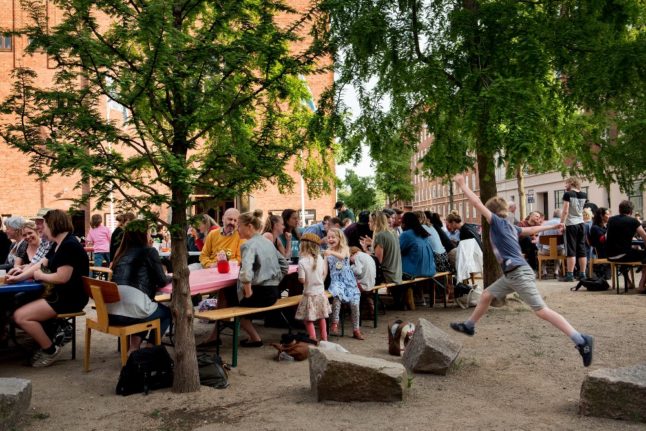Altså
This is a useful filler-word which can be used to mean “accordingly”, “thus”, “therefore”, “indeed” or “I mean”, but doesn’t exactly match any of them.
It is, however, also a much more articulate alternative to saying ”err”, which is how it often fits into sentences.
If you’re familiar with the German word also (which is not the same as “also” in English), altså will feel a bit more recognisable. The Danish word is formed of two adverbs: alt (everything) and så from således (“like this” or “in this way”).
Sådan
Translated as “such”, sådan is related to således (see above) and can be used in many ways, including as a filler-word, to mean “there we go”, “like that”, “in this way”. It can also be used when you have finished something, to mean “done.”
You may hear it used as an exclamation to praise someone: Sådan, mand! means something akin to “way to go, man!”
Jo
Pronounced ‘yo’, it means yes, but can only be used in response to a negative question or statement.
Examples where it would be used to mean “yes” (rather than the normal Danish word, ja):
Tog du ikke opvasken i aftes? — Jo, det gjorde jeg inden jeg gik i seng.
Did you not wash the dishes last night? – Yes, I did it just before I went to bed.
Du tog altså ikke opvasken i går. — Altså, jo, det gjorde jeg.
You didn’t even wash the dishes last night. – Er, yes I did.
Jo can also be used in the middle of a sentence to add emphasis. This use is near-impossible to translate and will often be omitted in the English version of a sentence, with context hopefully filling in to add some natural emphasis.
Pyt
This is a very satisfying word to say and is used as an interjection after a mistake or frustration. The closest English translation is “never mind”, “don’t worry”, “stuff happens”. But pyt also comes with a positivity, to express that you accept a situation is out of your control and there’s no need getting worked up about it.
Pyt is also used to comfort other people and diffuse situations. In 2018 it was chosen as Denmark’s favourite word.
Variations with the same meaning include pyt med det, pyt skidt and tage pyt-hatten på.
READ ALSO: The seven stages of learning Danish every foreigner goes through
Orke, gide
These two verbs are used to express the same thing; that you can’t be bothered to do something or that you don’t have the strength for it.
Jeg gider ikke tage opvasken (“I don’t feel like doing/can’t be bothered to wash the dishes”) is a phrase you might hear someone say at the end of a tiring day.
Orke is a slightly stronger version of gide. Commonly heard in the phrasing: “Jeg orker det simpelthen ikke” (I simply can’t be bothered).
It’s common to hear children say gider ikke in formulations like det gider jeg ikke, which would be the equivalent to “I don’t want to” in response to being asked to do a chore.
On the flip side, you can also gide godt when you are keen to partake in something. Skal vi ses til et glas vin på fredag? – Ja, det gider jeg godt (“Shall we meet for a glass of wine on Friday? – Yes, I’d like that”).
Træls
Træls belongs to local dialects in Jutland, although it’s also very common to hear it in Copenhagen. It is used to describe something annoying, tiresome, exasperating, inconvenient or just plain boring.
Jeg fik en bøde på 600kr fordi min baglygte var gået ud. — Ej hvor træls.
I’ve been fined 600 kroner by because my rear bicycle light wasn’t working. – Oh, how annoying.
Fælles
Can be variously translated to shared, joint, common or together. But it also encompasses a feeling and concept of community and togetherness that is hard to describe in English.
It can be used in many variations, such as fællesskab, which means community, fælleshave, a “community garden”, and fællesspisning, an initiative to eat together as a community. This is becoming increasingly popular in Danish cities, as a way to bring people together, where the food is made en masse, served at the same time and is a chance for people to connect over food.
Miljø
The literal translation of miljø, like the French milieu is “environment”, referring to the planet and green issues. But it can also be used when talking about different types of social circles and hobbies.
Studentermiljøet is used to describe the social aspect of student life. Venstreorienterede miljøer is “left-wing social circles” or “left-wing communities”. For hobbies, it can describe enthusiasts of most things: bilentusiaster (car enthusiasts) are part of the bilentusiast-miljø or “car enthusiast community”.
It is also used in arbejdsmiljø, (“work environment”), which relates to both the physical and mental affects of a workplace on its staff.
Overblik
A blik is a glance, view or momentary image of something, as the word øjeblik, literally “blink of the eye” but meaning “moment”, attests.
If you have an overblik over something, you have a view “over the top” of it or, more accurately described, a clear view of the whole thing. How this is used depends on context but usually it means something like “understand what is going on”.
Politiet har ikke flere kommentarer, indtil det har det fulde overblik over situationen.
The police has no further comments until it has a full picture of the situation.
Udgangspunkt
While udgang means “way out” or “exit” and punkt is “point”, udgangspunkt is often translated to “point of departure”, but this term feels a bit awkward in English. It also seems a bit inaccurate given that “departure” in Danish is not udgang, but afgang. Confusing prefixes lead the way here.
When you hear someone say som udgangspunkt, i udgangspunktet or vores udgangspunkt er, what they are telling you is that they have adopted a given initial stance or position on an issue and that will be their default approach unless they are given good reason to change it.
Regeringens udgangspunkt er at vi skal skære i de offentlige udgifter.
The government is of the view that we should cut public sector costs.
Hygge
We’re sure you’ve heard the word hundreds of times by now, but we had to include hygge on this list, despite the fact that it is technically now also an English word. Often mistranslated to “cosy” or a feeling of being together with loved ones, there is no direct equivalent English word to hygge.
Hygge is arguably the most translatable word on this list, however. In the vast majority of contexts in which it is used, it simply means “having a nice time”.
READ ALSO:



 Please whitelist us to continue reading.
Please whitelist us to continue reading.
How is pædagog not on this list?! Still no idea how to properly translate it…